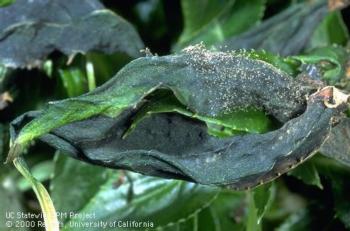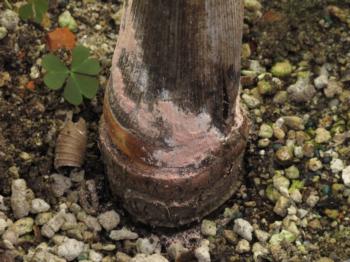Regional Report for Ventura County by Jim Downer

Fig. 1. Gray mold on New Guinea impatiens, Impatiens wallerana. Photo: Jack Kelly Clark.
The days are getting shorter, a chill is in the air but the drought is still holding. Environmental conditions are often predisposers of disease and while typically dry conditions suggest less fungal disease, this is not always the case in nurseries. Cooling weather is a time to be watchful for diseases caused by
Botrytis. Botrytis cinerea, the asexual stage of
Botryotinia fuckeliana,is a necrotrophic fungus that uses enzymes to dissolve host tissues and then absorb the remains. This fungus thrives in cold and wet conditions and will rapidly invade wounded or frost-injured plants. Herbaceous plants or flowers of woody plants (Rose) are particularly susceptible to Botrytis rots. These are quickly diagnosed because the mycelium is easily seen growing on affected plants as “gray mold” which gives it the same common name (fig. 1). Actually the gray part is comprised of spores (conidia) that occur in bunch-like clusters. (Botrytis is Neo-Latin and originated from the Greek
botrus for “bunch of grapes.”) Botrytis rot affects over 200 crop hosts and likely more plants that have not been studied. While various classes of fungicides are available for control, the pathogen is genetically pliable and easily resists typical fungicide regimes. Since the pathogen reproduces rapidly by asexual spores (conidia) it is important to rogue affected plants or trim and dispose of affected parts. Increased spacing to prevent plant-to- plant contact will also slow spread of gray mold. For more information on gray mold see:
http://www.ipm.ucdavis.edu/PMG/r280100511.html.

Fig. 2. Pink rot disease on a king palm trunk. Photo: Jim Downer.
Another cool weather disease is pink rot of palms. Also a fungal disease, it is caused by the pathogen
Nalanthamala vermoesenii. Many remember the old name
Penicillium, which was later changed to
Gliocladium and finally revised to
Nalanthamala in 2005. Pink rot gets its name from the masses of salmon-colored spores that occur on rotted palm tissues. Pink rot disease has a modest host range within the palm family. It primarily affects king palm (
Archontophoenix cunninghamiana) but also causes disease in
Chamaedorea, Syagrus, Trachycarpus and
Washingtonia filifera. The disease is either a bud rot or a trunk rot. The bud rot affects the terminal bud which leads to distorted growth, stunting or death of that stem. The trunk rot is a canker-like lesion that occurs mostly on the king palm (fig. 2). While typically associated with trunk rots of queen palm, the pathogen has never been proven to cause this disease. Pink rot is only able to grow in cool weather less than 70° F. It is also associated with wounds, especially in its trunk-rot phase. It is imperative that clasping leaf bases (crownshafts) of king palm not be torn from the trunks of nursery palms. Palms injured by frost often become infected with the pink rot pathogen during the same cool period. Pink rot is well controlled by EBI (ergosterol biosynthesis inhibiting) fungicides such as thiophanate-methyl and other newer materials. Avoiding wounds and providing frost protection usually prevents most disease. Fungicides applied in advance of sporulation may help slow progress of the disease and lessen rot symptoms.
Jim Downer
Environmental Horticulture Advisor
UC Cooperative Extension Ventura County
669 County Square Drive, #100
Ventura, CA 93003-5401
(805) 645-1458 phone, (805) 645-1474 fax
ajdowner@ucanr.edu
http://ceventura.ucdavis.edu














